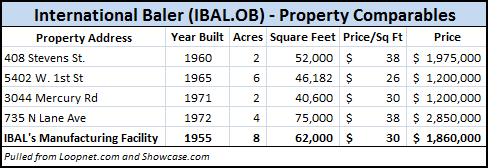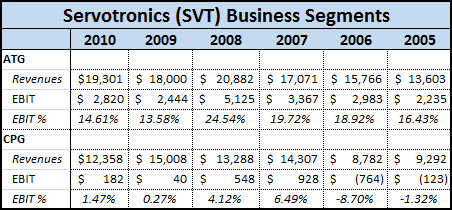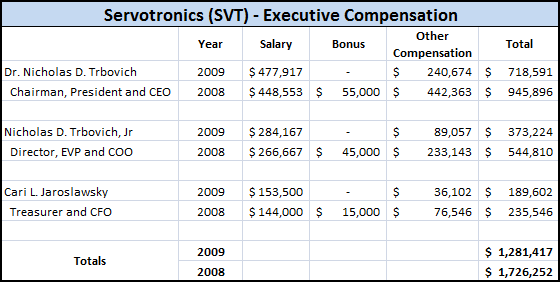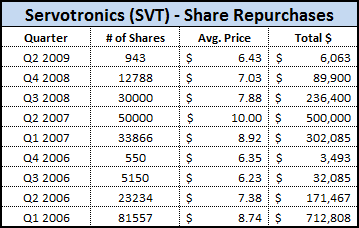International Baler Corp (IBAL.OB) is manufacturing company that has been in business since 1945 and currently qualifies as a net-net stock investment.
The company manufactures baling equipment, large complicated machinery that compresses a variety of materials (including scrap metal, boxes, cans, etc) into bales for easier shipping, storage, and recycling.
A leader in the field, especially for made-to-order and customized baling equipment, International Baler has over 40,000 units installed worldwide.
The stock suffered through a rough 2009 (along with many heavy equipment manufacturers) as customers put off cap-ex purchases – the company’s products cost between $4k and $500k.
A micro-cap stock with a market capitalization of only $3.5m, IBAL’s balance sheet remains rock solid, and the stock price has barely moved despite strong evidence that financials are strengthening in a big way.
Company Financials
After 6 years of steady growth in revenue from 2002-2008, IBAL saw a sharp sales decrease in 2009, with sales dropping 48.4%. The company suffered a small net loss, its first since 2003, as orders for every type of product were down across the board.
IBAL bounced back in 2010, with revenues up 16% and profits coming in at $254k.
Gross margins have remained steady over the past 5 years with a median just under 20%, while both operating and net margins hover around 5%.
For the year, these results translated into an EPS of $0.05 and owner earnings of $336k, for a CROIC and FCF Yield of 13.84% and 17.3% respectively.
2010 ROE was only 6.46%, as the company has consistently stockpiled cash to go along with an unused $1M credit line.
Overall, IBAL is a company that has gone about its business for over 50 years – although the recent recession affected the numbers in 2009, the company has proven it has the power to stay afloat during tough times.
Quarterly Analysis
Although it will probably take some time to match 2008 levels – a banner year – the latest quarterly reports show signs of improvement, not only in the actual numbers but in management’s language.
From the Q1 report last year:
“The decrease in revenue is the result of lower shipments in the first quarter of fiscal 2010, reflecting the deteriorated market conditions and lower commodity prices for recycled materials compared to the prior year first quarter”
And the latest quarter:
“This increase in revenue is the result of higher shipments in the first quarter of fiscal 2011 reflecting the improved market conditions and higher commodity prices for recycled materials compared to the first quarter 2010… The market for baling equipment has been moving toward larger, more productive and efficient equipment in recent years.”
This movement towards larger baler equipment is a good sign for the company, as there is much less competition on the high-end products (along with higher margins as well).
The recently released Q1 results show another sales increase, up 18% to $1.8m compared to the prior quarter last year.
Pre-tax income increased to $68k, compared to nearly zero last year, benefiting from higher product shipments and continuation of the company’s cost reduction efforts in 2009.
Even better, IBAL’s sales backlog more than doubled to $3.2m compared to $1.59m in 2010.
For comparison purposes, the backlog on Jan 31, 2008 was $2.8m – a year in which the company had sales and EBIT of more than $12m and $1.2m respectively!
While the company likely won’t approach those results, it has definitely gotten off to a good start in 2011.
Yet, despite the positive outlook, the stock has barely moved. In fact, it now trades at a discount to its working capital – compare the market cap $3.5m to net working capital of $3.68m.
Cash now sits at $3.08m, or $0.62 per share, unencumbered by any debt.
So IBAL is currently trading for less than working capital despite being solidly profitable, earning decent returns on capital, and announcing a record backlog!
Risks
Insider Ownership
Company insiders hold 58.8% of outstanding stock – I like to see management have a stake in the business but am cautious when the stock is so closely-held, as management can set compensation and make decisions at the expense of minority shareholders.
Digging into the latest proxy statement, the husband and wife team of LaRita & Leland Boren collectively own 51%, giving them tight control over the future of the company.
Outside of the Boren’s, little stock is owned by other company insiders or directors.
Recessionary Pressure
The company’s short-term results are heavily dependent on the economy. As commodity prices rise, it becomes more attractive and economical to purchase recycling equipment such as balers.
While the economy is showing signs of growth, a double-dip recession could reapply pressure to IBAL’s customers, potentially delaying purchases into the future.
Employee Lawsuit
On August 26, 2010, IBAL was served with a wrongful death lawsuit from a former employee for events that had occurred back in 2008. The lawsuit is asking for $2.5m, a huge potential liability for a company this small.
Lawsuits can be fickle and the company has liability insurance that should help cover any losses, but these sorts of cases can take a great deal of time and resources away from day-to-day responsibilities.
Positives
High-end Custom Baling Equipment
These special order products can cost up to $500k and offer much higher profit margins than traditional equipment.
These special orders remain a key growth segment for the company going forward – with such a wide array of configurations and over five decades of experience, the company is well positioned in the marketplace to capture the trend towards higher-end and custom equipment.
Undervalued Assets
The company owns its manufacturing facility in Jacksonville, FL, situated in a prime location next to a railroad and near a major highway. The facility is 62,000 square feet and sits on 8 acres.
With no mortgage, the company has depreciated the land, building, and all its contents down to $795k.
The land and buildings should be worth substantially more than the current carrying cost. Here are a few comparables:

Assigning a rough estimate at $30/sq ft to IBAL’s facility would yield a comparable value of almost $1m more than the current carrying cost (just for the building and land) – that’s almost $0.20 per share of additional value.
While it is unlikely that the company would sell the facility anytime soon (in fact, they had plans to expand the operation at one point), it is still a significant consideration for a company with a market cap of only $3.5m.
Insider Buying
John Martorana, a newly elected director, purchased almost 20k shares in the fall of 2010 at prices ranging from $0.45 – $0.52.
While the dollar value isn’t significant, insider buying is nearly-always a good sign for future prospects.
The CFO recently exercised his options and now holds 250k shares – it will be interesting to see what he chooses to do with this newly acquired stake in the business.
Valuation

There is no doubt that the stock is cheap on an asset basis – book value sits at $0.927, so the stock is trading at a P/B ratio of 0.75x.
Using Graham’s definition, the stock is a net-net, trading below its NCAV of $0.74.
Typically, these figures provide a measure of protection by limiting risk on the downside in the case of a liquidation.
Using TTM figures and the recent $0.70 stock price, IBAL trades for .75x EV/EBIT and only 1x EV/FCF, making it one of the cheapest stocks I’ve ever seen.
Consider this:
If the current sales and cash flow trend continue, the company will generate more owner earnings in a single year than the entire enterprise value of the company.
Conclusion
I’ve been purchasing shares for the past several months under $0.60 – basically picking up a piece of a growing, profitable business for less than the cash on the balance sheet.
At that price, the company actually has a negative enterprise value, meaning the market thinks that the baling business is worth more dead than alive – and yet it is very much alive.
Book value has compounded at 22% per year since the Boren’s took over in 2005, and the large jump in backlog should forecast good things in the coming months.
With a solid balance sheet, competitive products, and undervalued assets, the company is ripe for an acquisition or merger.
Tragically, LaRita Boren passed away in February 2011, meaning her ownership stake passes to an Estate controlled by her husband, Leland Boren.
Leland Boren, now 87, not only controls IBAL, but is also in charge of Avis Industrial Corporation, a conglomerate of industrial companies including one of IBAL’s competitors, American Baler Corporation.
With the recent passing of Mrs. Boren, and the advancing age of Mr. Boren, estate planning is surely a consideration – I think the company is now poised to unlock shareholder value via a number of different catalysts – whether it is a merger with Avis Industrial or an outright sale.
Long term, the increase in fuel prices and other commodities, along with greater awareness and acceptance towards recycling, will only increase the need for the International Baler’s products.
At current prices, IBAL represents one of the most undervalued stocks I’ve ever seen.
Disclosure
Long IBAL
Other Articles on IBAL
Bailing out of the bailed out market and into International Baler (Ragnar)






